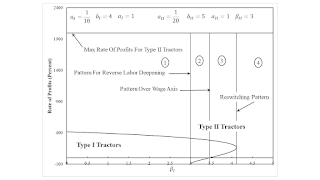Figure 1: Variation in the Cost-Minimizing Technique with Selected Coefficient of Production This post reports on some work with Steedman's corn-tractor model. I have yet to find an instance of triple-switching. I have found a case of reswitching, though. Figure 1 above and Table 1 below show how switch points vary with perturbations of the labor needed to produce a bushel of corn in the corn industry with Type I tractors. Only one switch point exists in region 1. Around this switch point a lower rate of profits is associated with the production and use of Type I tractors, an increase in consumption per labor-year, and a decrease in labor inputs in the corn industry per bushel produced. In other words, this switch point conforms to obsolete marginalist intuition. Table 1: Regions
Topics:
Robert Vienneau considers the following as important: Example in Mathematical Economics, Sraffa Effects
This could be interesting, too:
Robert Vienneau writes Austrian Capital Theory And Triple-Switching In The Corn-Tractor Model
Robert Vienneau writes Double Fluke Cases For Triple-Switching In The Corn-Tractor Model
Robert Vienneau writes The Emergence of Triple Switching and the Rarity of Reswitching Explained
Robert Vienneau writes Recap For A Triple -Switching Example
| Figure 1: Variation in the Cost-Minimizing Technique with Selected Coefficient of Production |
This post reports on some work with Steedman's corn-tractor model. I have yet to find an instance of triple-switching. I have found a case of reswitching, though.
Figure 1 above and Table 1 below show how switch points vary with perturbations of the labor needed to produce a bushel of corn in the corn industry with Type I tractors. Only one switch point exists in region 1. Around this switch point a lower rate of profits is associated with the production and use of Type I tractors, an increase in consumption per labor-year, and a decrease in labor inputs in the corn industry per bushel produced. In other words, this switch point conforms to obsolete marginalist intuition.
| Region | Description |
| 1 | Around switch point, Type I tractors are cost-minimizing at a lower rate of profits, higher wage. |
| 2 | Reverse labor deepening. Around switch point, Type I tractors are cost-minimizing at a lower rate of profits, higher wage. Increased wage is associated with more labor employed in corn industry. |
| 3 | Reswitching. Type II tractors are cost-minimizing at high and low rates of profits. |
| 4 | Type II tractors are cost-minimizing throughout. |
A single switch point exists in region 2 as well. This switch point is like that in region 1, except a lower rate of profits around the switch point is associated with an increase in labor inputs in the corn industry. This is a case of the reverse substitution of labor.
Region 3 is an example of reswitching. In region 4, both switch points have disappeared. Figure 2 below is much like Figure 1, but the wage is graphed on the ordinate.
| Figure 2: Variation in Wage at Switch Points |
I also graphed two of my fluke switch points. Figure 3 is for a switch point on the wage axis. It is at the partition between regions 2 and 3 in the above graphs. Figure 4 is for what I call a reswitching pattern. It is at the partition between regions 3 and 4.
| Figure 3: Pattern over Wage Axis |
| Figure 4: Reswitching Pattern |
Consider the switch point at the higher rate of profits in region 3. Around this switch point, a lower rate of profits is associated with adoption of the technique in which Type I tractors are produced and used. Consumption of corn per employed worker is decreased. Suppose, incoherently, that a lower rate of profits is an indication that consumers are more patient and supply more capital. The example clarifies that identifying a type of machine as more capital-using or labor-saving cannot be seen from a physical characterization of machinery alone.
I am still seeking parameters in which triple-switching occurs. To find the above case, I needed to find the roots of a fourth degree polynomial. I am looking for a case in which all roots are real, and three are positive and less than the maximum rate of profits.
It also would be nice to find reswitching in the special case in which the following is true for each type of tractor:
a/b = alpha/beta
Reswitching in this special case contradicts Samuelson's 1962 account of surrogate production functions. He claims that reswitching is impossible here. The difference is that Steedman analyzes depreciation rigorously, not with an approximation of radioactive decay.
 Heterodox
Heterodox




